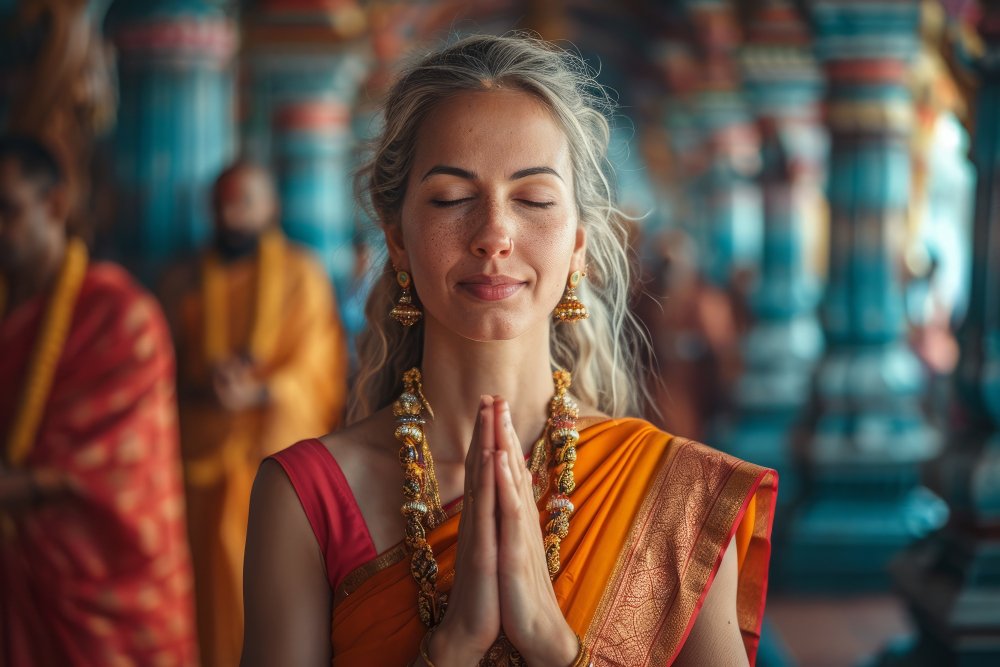Exploring the Spiritual Meaning of Namaste

Namaste, a familiar greeting that has gained worldwide popularity, holds a profound spiritual significance rooted in Hinduism. Derived from Sanskrit, the word “Namaste” translates to “I honor or bow to you.” This ancient tradition is not limited to Hinduism and extends to other religions like Buddhism and Jainism. The act of folding hands near the chest, with palms touching, symbolizes a connection that goes beyond physicality. It is a way of acknowledging the divinity within each individual and fostering respect, unity, and spiritual growth.
Namaste represents a deeper meaning in spirituality, signifying more than a simple greeting. It conveys respect, gratitude, and love towards oneself and others. By saying “Namaste,” one acknowledges the divine spark within oneself and recognizes the worth of the person in front. This gesture serves as a bridge to connect with a higher power and promotes inner peace and well-being in both mind and body. The gesture of folding hands near the chest resembles the lotus flower, symbolizing purity and enlightenment.
Key Takeaways:
- Namaste is a greeting with deep spiritual significance.
- It originated in Hinduism but is also practiced in Buddhism and Jainism.
- The word “Namaste” translates to “I honor or bow to you.”
- By folding hands near the chest, a connection is formed, acknowledging the divinity within.
- Namaste promotes a sense of calm, unity, and well-being.
The Meaning and Significance of Namaste
In Hinduism, the word “Namaste” carries profound spiritual meaning. It is more than just a greeting; it is a way of expressing respect, gratitude, and love. When we say Namaste, we are essentially saying, “I bow to the divine in you.”
The significance of Namaste lies in its ability to acknowledge the presence of the divine spark within ourselves and others. It serves as a reminder that we are all connected and share a common essence of divinity. Namaste cultivates a sense of unity and oneness, recognizing the inherent worth and value of every individual.
By folding our hands near the chest in a gesture of Namaste, we create a connection with a higher power and invite a sense of calm and well-being into our lives. This simple act can have a profound effect on our mental and emotional state, promoting inner harmony and balance.
The hand position of Namaste also holds symbolism. The gesture resembles a lotus flower, a powerful symbol in Eastern spirituality. The lotus represents purity, enlightenment, and the blossoming of one’s inner self. When we perform the Namaste gesture, we are symbolically aligning ourselves with these qualities and embracing the path of spiritual growth.
In addition to its spiritual significance, Namaste teaches us the importance of respect and humility. It reminds us to treat others with kindness and compassion, recognizing their intrinsic worth. Through Namaste, we can foster a sense of love and acceptance, creating a harmonious and interconnected world.
Next, we will explore the different mudras or hand gestures used in Namaste and their meanings.
The Mudras of Namaste

One of the defining features of Namaste is the use of hand gestures, or mudras, that carry deep symbolic meaning. These mudras not only add visual beauty to the gesture but also enhance its spiritual significance.
Here are some of the different Namaste mudras and their meanings:
Anjali Mudra
| Mudra | Meaning |
|---|---|
| Anjali Mudra | The palms are pressed together in front of the heart chakra, representing respect, gratitude, and love. |
| Pranamasana | The palms are pressed together in front of the chest with the fingers pointing upwards, representing reverence and respect. |
| Abhaya Mudra | The right palm is raised with the fingers pointing upwards and the left palm is facing outwards, representing fearlessness and protection. |
The Anjali Mudra is perhaps the most widely recognized Namaste mudra. It involves pressing the palms together near the heart chakra, with the fingers pointing upwards. This mudra symbolizes respect, gratitude, and love. It is a way of acknowledging the divine spark within oneself and others, and expressing deep reverence.
Pranamasana is another common Namaste mudra. In this gesture, the palms are pressed together in front of the chest, fingers pointing upwards. This mudra signifies reverence and respect towards oneself and others. It is a gesture of honoring the divinity within and recognizing the intrinsic worth of every being.
Abhaya Mudra is a mudra that represents fearlessness and protection. It involves raising the right palm with the fingers pointing upwards, while the left palm faces outward. This gesture symbolizes the absence of fear and the assurance of safety. It is a way of invoking courage and warding off negative energies.
The different Namaste mudras provide a variety of expressions within the gesture, each carrying its own unique interpretation. Whether it is the Anjali Mudra, Pranamasana, or Abhaya Mudra, each mudra adds depth and meaning to the spiritual practice of Namaste.
The Purpose and Benefits of Namaste

Namaste is not just a simple greeting; it has a deeper purpose. It serves as a gesture of respect and a way to acknowledge the divinity within oneself and others. By folding the hands together near the chest and bowing, one shows humility and a willingness to honor the sacred within others. Through this gesture of respect, Namaste creates a spiritual connection that transcends boundaries and fosters understanding.
One of the main benefits of practicing Namaste is the calming and balancing effect it has on the mind and body. It promotes a sense of peace and well-being, reducing stress and enhancing emotional stability. Scientific research has also shown that Namaste can boost immunity and improve mental clarity, making it a valuable practice for overall wellness.
Furthermore, Namaste is a way of spreading love and positivity. By recognizing the divine in ourselves and others, we cultivate a mindset of compassion and kindness. Namaste encourages us to see beyond differences and to treat everyone with loving respect. It is a reminder of our inherent interconnectedness and the power we have to make a positive impact in the world.
In conclusion, Namaste serves a higher purpose of acknowledging the divine within ourselves and others. It offers numerous benefits, including stress reduction, improved mental clarity, and boosted immunity. Furthermore, Namaste encourages the spread of love and positivity, fostering a mindset of compassion and interconnectedness. By incorporating Namaste into our lives, we can enhance our well-being and create a more harmonious world.
Conclusion
Namaste, a powerful gesture that transcends a mere greeting, holds deep spiritual significance. It serves as a symbol of respect, unity, and reverence for the divine within every individual. Beyond its surface-level customs, the practice of Namaste fosters connection, mindfulness, and a sense of interconnectedness.
By embracing the spiritual meaning of Namaste, we acknowledge the sacred essence within ourselves and others. This gesture promotes a culture of respect, humility, and appreciation for the inherent divinity present in every living being. Namaste serves as a reminder that we are all connected, bound by a collective consciousness that seeks harmony and understanding.
In a world that often emphasizes separation and differences, the practice of Namaste offers a path towards unity. It invites us to celebrate the common thread that unites us all—the spark of the divine that resides within. By embracing the spiritual significance of Namaste, we can create a more compassionate, harmonious, and mindful world for ourselves and future generations.
A genuine Namaste not only bridges the gap between individuals but also enables a profound spiritual connection. It is a gateway to inner peace, love, and acceptance. Through this sacred gesture, we cultivate a deep sense of awareness and appreciation for the beauty and sacredness of life.













[…] Exploring the Spiritual Meaning of Namaste Namaste, a familiar greeting that has gained worldwide popularity, holds a profound spiritual significance… Explore Top Spirituals Artists & Their Music | Power of Sacred Sounds Welcome to our exploration of the world of top spirituals artists and their music. In this article, we… Exploring the Profound Spiritualism Meaning for Personal Growth In today’s fast-paced and interconnected world, spiritualism meaning has become increasingly relevant… Exploring Spiritual Synonyms for Inner Peace In today’s fast-paced world, finding inner peace can seem like an elusive goal. Mindfulness and… Unveiling the Tree of Life Spiritual Meaning | Explore Profound Symbolism The Tree of Life holds a profound spiritual meaning across various traditions and cultures. It is a powerful… Unveiling the Spiritual Reasons Behind Why Do I Wake Up at 4AM Have you ever found yourself waking up at 4AM, wondering why it seems to happen so often? This early… No posts found […]
[…] come across the number 1010 Meaning Spiritual in your daily life and wondered if it held… Exploring the Spiritual Meaning of Namaste Namaste, a familiar greeting that has gained […]